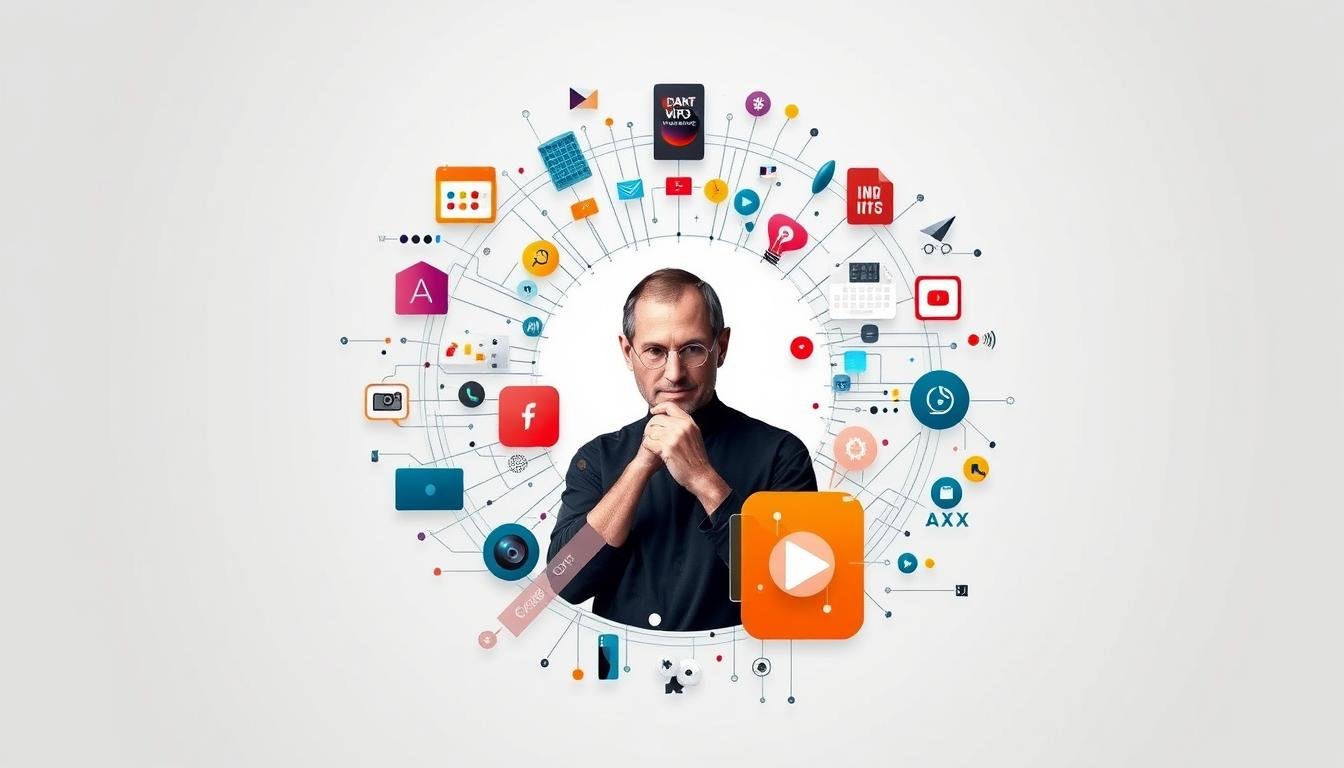Steve Jobs: Innovation, Design, and the Revolution of Technology Industries
In the 1970s, a young man in Los Altos, California, was working in his parents’ garage. Steve Jobs, the co-founder of Apple Inc., changed the tech world. He made personal computing, mobile tech, and digital media better through his innovations.
Steve Jobs’ story shows Silicon Valley’s magic. It’s where dreams and hard work come together. In this place, Jobs co-founded a top company and changed how we use technology. His work made tech easy and fun.
Jobs loved details and simplicity, like the Bauhaus art movement. He inspired his Apple team to make products that look good and work well. This led to the creation of famous products like the Macintosh and iPhone.
This journey into Steve Jobs’ work will show how he changed tech industries. His leadership and innovation were groundbreaking. For those interested in tech or entrepreneurship, Jobs’ story is full of lessons on design and perfection.
Steve Jobs: Early Life and Career Beginnings
Steve Jobs was born on February 24, 1955, in San Francisco, California. He grew up in what is now known as Silicon Valley. This area was full of new technology and big names in the industry. Jobs had a tough time in school; he was seen as a loner and didn’t like following rules. But his fourth-grade teacher helped spark his love for learning and innovation.
The Role of Silicon Valley
Jobs spent his early career in Silicon Valley, where he was exposed to cutting-edge technologies. In high school, he met Steve Wozniak at the Hewlett-Packard Explorers Club. This meeting was crucial, starting a lifelong friendship and partnership that led to big changes in technology.
Founding Apple with Steve Wozniak
In 1976, Jobs and Wozniak started Apple Inc. with a goal to bring new products to the market. Their work led to the Apple I, priced at $666.66. The Apple II, launched in 1977, was a major success, making Apple a leader in technology.
By 1980, Apple was worth $1.2 billion after going public. Under Jobs, Apple introduced products like the iMac, iPod, and iPhone. These products changed the game and set Apple apart. Jobs believed in the power of innovation to lead and make a difference.
| Key Milestones | Details |
|---|---|
| 1955 | Steve Jobs was born in San Francisco, California. |
| 1976 | Jobs co-founded Apple with Steve Wozniak. |
| 1977 | Apple II launched, marking significant success. |
| 1980 | Apple’s public offering valued at $1.2 billion. |
| 1997 | Jobs returned to Apple, leading to the introduction of the iMac and other iconic products. |
| 2011 | Steve Jobs passed away, leaving a lasting legacy. |
| 2022 | Posthumously awarded the Presidential Medal of Freedom. |
The Influence of Design on Steve Jobs’ Philosophy
Steve Jobs loved design from a young age. He was inspired by his surroundings and great designers. This shaped his philosophy, which made Apple’s products iconic.
The Impact of Joseph Eichler’s Homes
Living in a Joseph Eichler home changed Jobs’ view on beauty and usefulness. Eichler homes are famous for their modern look and focus on simplicity. They had open spaces and brought the outdoors inside. This style influenced Jobs, teaching him to value simplicity and practicality in design.
Inspirations from Sony and Bauhaus
Jobs was inspired by Sony and the Bauhaus art school. Sony’s clean designs and advanced features showed him the power of minimalism. Bauhaus believed in modern and functional design, which shaped Jobs’ vision for Apple.
He saw this in Apple’s products like the Apple II, iMac, and iPhone. These influences created a unique design ethos for Apple. It focused on combining beauty with practicality.
Steve Jobs and the Innovation of Technology Industries
Steve Jobs was born on February 24, 1955, in San Francisco, California. He co-founded Apple Computer, Inc. in 1976 with Steve Wozniak. Jobs led a tech revolution that changed many industries with his innovative leadership.
In 1984, Jobs launched the Macintosh computer, changing personal computing forever. This showed his focus on making products that were both useful and easy to use. He believed in making design that worked well, not just looked good.
After leaving Apple in 1985, Jobs came back in 1997. He led Apple to create new products like the iPod in 2001, iPhone in 2007, and iPad in 2010. These products combined technology and design in a way that changed everything.
The iPhone, for example, changed mobile technology. It let people browse the internet, watch movies, and text all in one device.
Jobs believed that innovation distinguishes between a leader and a follower. He made the graphical user interface popular and encouraged thinking differently. His focus on simplicity has greatly influenced today’s tech products.
At the time of his death on October 5, 2011, Steve Jobs had 241 patents. His drive for perfection has pushed technology forward. From the Apple I in 1976 to the MacBook in 2006, his work has changed our lives.
Simultaneously a Visionary and a Disruptor: Steve Jobs’ Legacy
Steve Jobs changed the tech world in big ways. He was both a visionary and a disruptor. His work led to a personal computing revolution. At the same time, his approach in mobile tech set new standards. This made his visionary legacy strong.
Transforming Personal Computing
In 1984, Apple Macintosh changed how we use computers. It focused on easy-to-use interfaces and sleek designs. This shift started the personal computing revolution, making tech available to everyone.
Jobs made sure technology was easy for all to use. This changed the future of tech design and function.
Pioneering Mobile Technology
Jobs didn’t stop with personal computers. He made big strides in mobile tech with the iPod, iPhone, and iPad. These products changed how we use media, talk to each other, and work anywhere.
After Jobs passed away, people worried about Apple’s future. Would the new leaders keep up his innovative work? The loss of key people like Scott Forstall made some wonder about the company’s direction.
Now, Apple seems to focus on being stable and working together as a team. But Steve Jobs’ impact lives on. His “Think Different” campaign, created with Lee Clow and Rob Siltanen, still guides Apple. It shows how Jobs was both a visionary and a disruptor.
| Element | Impact | Significance |
|---|---|---|
| Apple Macintosh | Revolutionized personal computing | Ushered in user-friendly interfaces |
| iPod | Pioneered digital music | Redefined media consumption |
| iPhone | Transformed mobile phones | Set new standards for mobile technology |
| iPad | Innovated mobile computing | Expanded portable device market |
Key Innovations Introduced by Steve Jobs
Steve Jobs was a trailblazer whose innovative mind transformed technology sectors. Through Apple, he brought to life influential products that changed our world. He set the stage for future tech advancements.
Apple Macintosh
The Macintosh creation in 1984 was a turning point in personal computing. It introduced a graphical user interface (GUI) and a mouse. This made it easy for more people to use computers.
This Apple innovation started a shift from command-line interfaces to visual ones. It changed how we interact with computers.
iPod, iPhone, and iPad
Steve Jobs wanted to change the world of entertainment and communication too. The iPod, launched in 2001, changed how we listened to digital music. It made carrying thousands of songs in one device possible.
The iPhone, introduced in 2007, was a game-changer in mobile devices. It combined an iPod, a phone, and internet access in one. By 2018, it had sold over 1.6 billion units worldwide, setting new standards for smartphones.
The iPad, launched in 2010, expanded portable computing. It found a niche between laptops and smartphones, ideal for browsing and enjoying media. Like the iPhone, the iPad showed Jobs’ ability to create new markets.
| Innovation | Launch Year | Impact |
|---|---|---|
| Macintosh | 1984 | User Interface Revolution |
| iPod | 2001 | Digital Music Transformation |
| iPhone | 2007 | Mobile Devices Revolution |
| iPad | 2010 | New Category of Portable Computing |
Steve Jobs and Apple innovations have changed the digital world. They’ve pushed forward in personal computing, mobile devices, and digital music.
The Design Principles Steve Jobs Followed
Steve Jobs believed in design that was simple and elegant. He followed the idea that “less is more” and “simplicity is the ultimate sophistication.” Apple’s design philosophy is built on three key principles: simplicity in product design, a user-oriented approach, and combining form and function well.
Jobs made a big impact by focusing on simplicity in product design. He made technology easier and more intuitive. This led to the creation of products like the iPod, iPhone, and iPad. These products changed how we listen to music, communicate, and compute.
The iPhone, for example, changed mobile communication. It made the interface easy to use and the device sleek and simple.
Jobs also emphasized a user-oriented approach. He thought the user experience was most important. This was seen in the products’ graphical interface. For instance, the use of multiple typefaces and fonts in the Mac made it more visually appealing and functional.
Here’s a look at how Jobs’ design principles impacted the industry:
| Design Principle | Application | Impact |
|---|---|---|
| Simplicity in Product Design | iPhone, iPad, Mac | Enhanced User Experience, Intuitive Interfaces |
| User-Oriented Approach | Graphical Interface, Multiple Typefaces | Improved Accessibility, Aesthetic Appeal |
Jobs’ focus on combining form and function not only shaped Apple’s design philosophy but also set a new standard. This ensured that every product was both beautiful and useful. Apple became a leader in innovation because of this.
Apple still leads in the tech industry, thanks to Jobs’ legacy. His ideas about simplicity in product design, a user-oriented approach, and blending form and function are still seen in Apple’s innovations and success.
Buddhism and Minimalism: The Zen Influence
Steve Jobs loved Zen Buddhism and its simple way of life. This shaped his design ideas at Apple, making products sleek and simple. He wanted to solve problems with elegant, simple solutions, just like Zen teaches.
Simplicity and Focus in Design
Jobs wanted to make great design easy for everyone. He used Zen ideas to focus on what’s really needed in a product. This meant removing things that aren’t essential.
Dieter Rams, a German designer, also believed in simplicity. Jobs learned from him to really understand what users need. This led to the creation of the iPhone in 2007, a huge success worldwide.
Jobs saw a future where technology would be simpler and easier to use. This change marked a big shift in technology.
The Japanese Zen Aesthetic
Jobs admired Japanese design, especially Zen, and collected many ukiyo-e prints. He even thought about becoming a monk at Eiheiji Buddhist monastery. Zen ideas influenced Apple’s design, not just his personal life.
The first Macintosh computer had a digital version of a Zen art print. This shows how Zen ideas of simplicity helped create Apple’s clean designs. These designs made using technology smooth and easy.
In Japan, Apple is very popular, with a big share of the smartphone market. Designs like the Oluce Atollo Lamp show how Zen ideas inspire minimalism. This approach makes products clear and efficient, showing minimalism as a way to communicate and progress.
- Steve Jobs aimed for simplicity by conquering complexity.
- The Japanese Zen aesthetic inspired Apple’s uncluttered, functional designs.
- Apple controls over 60% of Japan’s smartphone market.
Jobs combined Zen philosophy with technology. He focused on simplicity, elegance, and design to make products loved by people all over the world.
Steve Jobs’ Management Style
Steve Jobs’ management style was key to Apple’s success. He demanded perfection and paid close attention to details. This led to significant growth, especially after the iMac’s release, which set sales records.
Jobs was known for setting high standards. He created an environment where only the best work was accepted. This pushed employees to excel. Apple focused on a few high-quality products, spending less on research but still outperforming competitors.
Jobs valued face-to-face meetings over emails. He believed these meetings sparked creativity and new ideas. He also held yearly retreats with his top team to set priorities. Only three out of ten ideas were chosen for action, showing his strategic focus.
| Aspect | Details |
|---|---|
| Focus | Fewer high-quality products |
| R&D Spending | Spent six times less than Xerox but yielded superior outcomes |
| Employee Standards | High expectations, no tolerance for mediocrity |
| Innovation | iPhone, App Store, iPad, revitalized Mac lineup |
| Leadership Approach | Faith in people, face-to-face interaction, annual retreats |
Jobs’ leadership and approach were key to Apple’s success. He made Apple the innovative brand it is today.
Steve Jobs: Innovation, Design, and the Revolution of Technology Industries
Steve Jobs changed the tech world in a big way. He made design and innovation key to tech growth. By 1984, only 8 percent of U.S. homes had a computer, but Jobs saw huge potential.
Time Magazine named the computer as Man of the Year, showing big changes were happening. Jobs used this to push Apple forward, even when IBM PCs were selling more. He focused on making Apple’s design stand out.
Jobs predicted millions of computer sales, making Apple a young Fortune 500 company. From 1997 to 2011, he led the release of the iPod, iPhone, and iPad. These products changed how we use technology every day.
Jobs didn’t just focus on making new products. He combined engineering with design for a better user experience. This made Apple a leader in tech innovation. He believed in making tough choices to have a lasting impact.
Jobs also valued teamwork at Apple. He trusted his gut in making innovations. After his death in 2011, Apple has focused more on small improvements, sparking debate.
Yet, Jobs’ legacy lives on, inspiring tech leaders with his focus on design and innovation. His drive to challenge the norm and his unique approach to product development still shape the tech world. He showed that thinking differently can change everything.
An Entrepreneurial Icon: Lessons from Steve Jobs
Steve Jobs was a giant in entrepreneurship, leaving behind many lessons for us. He believed in mixing humanities with sciences to spark true innovation. His unique way of thinking led to amazing products and ideas.
Combining Humanities with Sciences
Steve Jobs thought combining humanities and sciences was key. This mix helped him create products that were both high-tech and user-friendly. For example, the Apple I in 1976 was a groundbreaking personal computer kit.
The Apple II in 1977 showed off this blend even more. It had an integrated keyboard and was affordable, making Apple a leader in tech.
Embracing Unconventional Thinking
Steve Jobs also taught us the value of thinking differently. He brought us the iMac and iPod, showing his focus on simple design. His work was all about making things easy and beautiful.
He even spent a lot of time on small details, like the color of a factory or the best washing machine. This shows his dedication to making things perfect.
| Year | Product | Innovation |
|---|---|---|
| 1976 | Apple I | First mass-produced personal computer kit |
| 1977 | Apple II | Integrated keyboard; Affordable pricing |
| 1998 | iMac | Design simplicity and user-friendly interface |
| 2001 | iPod | Revolution in digital music player market |
“The intersection of technology and the humanities is where true innovation lies.” – Steve Jobs
Steve Jobs’s legacy teaches us a lot about combining different areas and using creative strategies. His innovative spirit and unique approach still inspire entrepreneurs today.
Conclusion
Steve Jobs changed the world with his approach to technology, design, and business. He co-founded Apple Computer Inc. in 1976 with Steve Wozniak and Ronald Wayne. Jobs had a unique skill in predicting trends and creating products that were both beautiful and functional.
He started with the Apple I and Apple II, which were huge successes. Then, he launched the Macintosh in 1984, showing his focus on user-centered design and innovation.
Jobs didn’t just stick to computers. He ventured into animated films, music, and mobile technology. He changed the music industry with the iPod and iTunes. And he made Pixar Animation Studios famous with hits like Toy Story and Finding Nemo.
Then, he introduced the iPhone in 2007, changing mobile phones forever. Jobs didn’t just make new products; he changed entire industries. His work has inspired many entrepreneurs and innovators.
Steve Jobs’ legacy shows his constant drive for design and innovation. His idea of simplicity and focus has set a high standard in product design. His work has greatly influenced technology and business.
Looking back, it’s clear that Steve Jobs’ vision and leadership will continue to inspire for many years. His life’s work shows us that combining technology and design can lead to amazing achievements.
Source Links
- How Steve Jobs’ Love of Simplicity Fueled A Design Revolution
- The Real Leadership Lessons of Steve Jobs
- 10 Lessons From the Legacy of Apple’s Steve Jobs
- Steve Jobs Bio: Career, Leadership Style and Quotes – businessnewsdaily.com
- Steve Jobs
- Steve Jobs: The Man Who Shaped Technology
- Steve Jobs’ Philosophy: Achieving Success and Fulfillment through Passion, Innovation, and Personal Growth
- Celebrating a Design Revolution: The Birth of iPhone and the End of an Era
- PORTRAIT OF A REVOLUTIONARY: Steve Jobs
- Steve Jobs’ 10 Most Innovative Creations
- Steve Jobs: A Biography of Innovation and Vision
- Innovation is a Fight
- The Real Story Behind Apple’s ‘Think Different’ Campaign
- Redefining Real Estate Innovation: Embracing the Spirit of Elon Musk and Steve Jobs
- How Steve Jobs Changed the World
- Research Guides: This Month in Business History: The Founding of Apple Computer, Inc.
- The innovation Secrets of Steve Jobs
- Unveiling the Legacy: The Enduring Lesson of Steve Jobs
- How Steve Jobs Love for Simplicity Fueled a Design Revolution
- The origins and essence of minimalism in Design and Architecture
- Steve Jobs: Made in California, Designed by Japan — Danny With Love
- The Leadership Style and Innovations of Steve Jobs: Impact on the Technology Industry
- Steve Jobs: ‘Technology is nothing’—here’s what he said it really takes to achieve great success
- Objects of Our Life | Steve Jobs Archive
- The 5 Pillars of Innovation according to Steve Jobs. — TheAudioPod.Com®
- Innovation: Lessons from Steve Jobs | PublishingState.com
- The Real Genius of Steve Jobs
- Steve Jobs – The Visionary and Innovator
- Steve Jobs and Apple: From Garage to Global Leadership | Ideia Veloz Business – entrepreneurship, business management
- E:
esonance-work
esowrk†4\October-2014-Editorial_October2014







